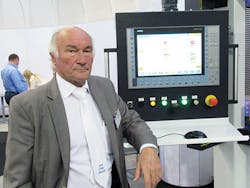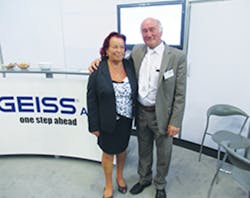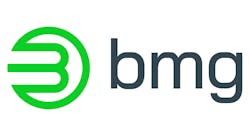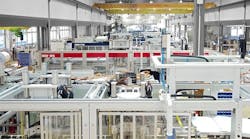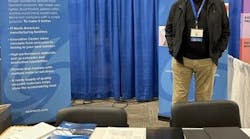Manfred Geiss joined his father's mold making and thermoforming machinery manufacturing company and together they built a business best known for its innovation and industry-leading technology. Once known as Geiss Fabrik, Geiss AG serves as the model of how a successful, mid-sized, family-owned business can carve out a niche in the plastics industry.
Geiss, 72, is still hard at work advancing thermoforming machinery technology and has positioned the German company for the next generation.
Geiss discussed his career recently with PMM Editor Ron Shinn at Fakuma in Germany.
Geiss: After the war, my father Georg was released from an American prison ship. He was a pattern and mold maker, so he started his own business in 1948. He came into contact with people who were forming thermoplastics and made molds for them. He told them they would not succeed unless they developed a closed-chamber system for pre-blowing. At the time, the whole world used an open-chamber system. They told him to make it for us, so, in 1961, he started building a vacuum forming machine.
How did you get started in the business?
Geiss: I was born as the next generation of Geiss Fabrik, so it was decided by birth that I would be a mechanical engineer. I loved it. It was exactly fulfilling for me. I came into the company with my father in 1970. It was a good partnership because my father was a typical self-made man, and I was a university-educated engineer. We collaborated and were good friends.
I grew in this business. My parents hired a young girl named Klara for office work, who I eventually married. My father was the big boss, I was the technical manager and my wife was assistant to the boss. She is now the financial manager and has been in the company for 58 years.
How did the company grow?
Geiss: Business in Europe grew and grew. My father and I developed a long list of inventions. I think we grew thermoforming in Europe from a primitive, black-magic process to a real industrial technology.
One of our customers asked us about a trimming machine, since you need to trim parts out of a flat sheet. We realized that if we did not find a solution, thermoforming could die out. I built the prototype for a CNC trimming machine in my spare time and, in 1984, we started selling our first trimming machine. This was a good thing for our business.
Then, we faced the problem that mold changes for thermoforming were too complicated. They had to deal with the frame, window plate and bottom frame. So, we developed mold adjustments that were automated and infinitely adjustable. These were core mechanical inventions we made. From this moment on, our customers did not need to change window plates, which are heavy steel plates. They no longer had to climb inside the machine to change the mold. And we could more or less automate this changeover. In 1994, this immediately gave Geiss a worldwide leading position.
What was the next big advance?
Geiss: In 2014, we developed the servo-motorized thermoforming press, which replaced the pneumatic drive. We have been completely overwhelmed with orders for this machine.
We also had the first vacuum forming machine with a flat design, the first with bottom heaters, the first to use microprocessors in the control system and the first automatic sheet feeding machine.
Was there a turning point in how you built machines?
Geiss: We figured out when computer-aided design, or CAD, first came out that we could design machines in an automated process. I think this was the core idea of my life, to build machines with a flexible computer system that designs machines automatically. Any change to a parameter in the program is automatically reflected in associated dimensions and components.
My question to a customer is always what size machine do you ideally want? On the first day of this fair, I sold a machine with a 1,060mm-by-710mm forming area because this was the size he wanted. We have standard sizes available because there are people who insist on them, but I think 80 percent of the thermoformers we build are non-standard sizes.
Was CAD a new idea when you started using it?
Geiss: Yes. For 19 years, I was the programmer. I learned four programming languages and still use them. Every machine we build starts with pieces of flat steel and tubes. This gives us flexibility other manufacturers do not have. If the CAD program calculates we need a steel angle profile of exactly 241mm, we build it. It is a simple idea and gives us complete quality control.
The computer program that designs the machine also develops programs to build it, including the robotic welding, laser cutting, milling and turning machines. Even the parts list. Two weeks ago, we developed an electrical wiring diagram with the CAD program. This is important because all of them are unique.
How do you see Industry 4.0?
Geiss: We introduced Industry 4.0 techniques in the early 1980s. Our production plant has 15 kilometers of fiber-optic lines distributing information. We started early with computerization. It was my hobby and still is because I found out that it was important to automate the industrial process. The company is paper-free.
Do you use robots?
Geiss: We have seven welding robots. Each robot handles an entire workpiece. The evolution to train those robots to weld my pieces took a long time, but now we do not weld by hand.
Who buys your thermoforming machines?
Geiss: We believe we will have delivered 100 thermoforming and CNC machines in 2018. About 80 percent are exported, with our biggest markets being the U.S. and China. In China, we are strong with our CNC trimming machines. Twelve themoforming machines went to the U.S., but they represent more than 12 percent of turnover [sales] because those machines are complex, expensive units.
More than 50 percent of our turnover worldwide is to automotive companies. We make turnkey solution, and automotive customers have the highest level of requirements, which we can fulfill.
What is the delivery time on your built-to-order machines?
Geiss: For years, I guaranteed my salespeople we would deliver a machine in no more than seven months. But since we developed the servo machine, delivery time is two years. I have 100 machines on order right now.
How many patents do you have?
Geiss: Eight current patents. Patents for the adjustable frame and adjustable window plate invented in 1994 have run out. The current patents are for the servo machine drive technology.
Will thermoforming ever challenge injection molding for market share?
Geiss: Yes, I think a very important part of
my life has been to bring thermoforming from making simple parts in small quantities to a highly industrialized process making a massive number of parts. One of our customers is providing up to 30,000 thermoformed parts a year to a customer and is competitive with injection molded parts. Through automation and higher productivity, the share of thermoforming in the whole plastics industry is growing.
The electromobility trend of the transportation industry is an opportunity for thermoforming to grab a bigger market share. A lot of small, different companies are thinking about transportation in different ways. My feeling is that a big share of exterior parts for these new vehicles will be made by thermoforming until quantities become big enough that they should be injection molded. There is a limit to what you can do with thermoforming, but we are moving that limit.
Would you advise young engineers to get into the plastics machinery business?
Geiss: Absolutely! I had a group of 25 university plastics engineering students visit our company, and I told them the world is unthinkable without plastics and we need engineers. Germany's strength is in engineering. We have no coal and no oil. We just have brains and they should use them.
Our first daughter is a plastics engineer, the second daughter works at Geiss, and she and her husband, Klaus-Peter Welsch, run day-to-day operations, and the third daughter is a doctor of chemistry working on new plastics. Our son is a physician. They all grew up by their mother's side in the factory.
How would you like to be remembered?
Geiss: I maintained our company's independence, but always in a fair way. I never tricked one of my customers, and I didn't want to be tricked. I have always [tried to have a clear standpoint and I never became a slave, even though sometimes automotive purchasing people want you to be. That does not work.


